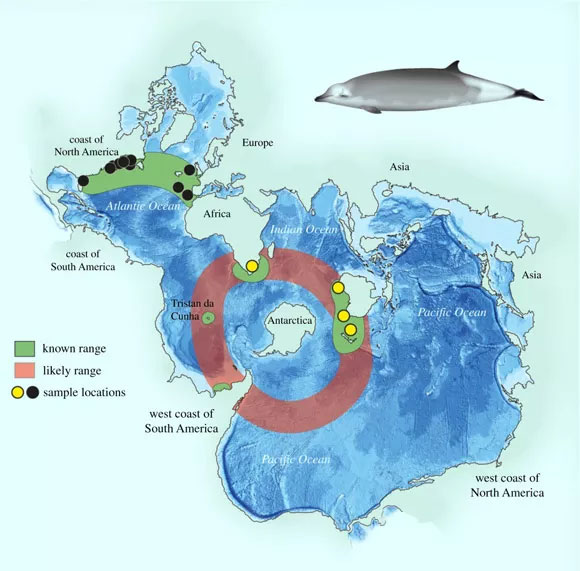Unknown scientific giants, appearing all over the Southern Hemisphere
A new species of creature discovered through corpses washed up on New Zealand's shores 10 years ago has scientists wondering: Earth's deep oceans are still less understood than the surface of Mars.
The new species, named Mesoplodon eueu , occurs throughout temperate seas in the Southern Hemisphere, according to surveys from locations off South Africa, Australia and New Zealand that have long been unknown to humanity!
According to a team from the University of Auckland, led by Dr Emma Caroll, the strange creature is a beaked whale, living in the deep sea, with diverse taxonomy and many mysteries in the history of the breed. species is still poorly understood.

The distribution map of the new organism was identified with the green areas being habitable locations, while the red areas were where an individual was occasionally spotted - (Image: Vivian Ward, University of Auckland).
Sheet Sci-News said the new findings from the research team analyzed the genetic data and morphology from some specimens stored in the natural museum. One of the specimens did not match any known species: the remains of a female whale found off the west coast of the South Island (Te Waipounamu) in Aotearoa New Zealand. When discovered, the whale carcass was up to 5 meters long and pregnant.
The whale carcass has been found since November 2011, but is mistaken for a true beaked whale (Mesoplodon mirus) . New research shows that the skull of this creature is completely different from the True whale, the creature that dominates the Northern Hemisphere.
Further analysis shows that they are indeed related, but that the two species diverged on the family tree half a million years ago.
This discovery brings the total number of known beaked whale species on Earth to 24. The detailed study has just been published in the scientific journal Proceedings of the Royal Society B: Biological Sciences.
- The sight of a comet in the southern hemisphere
- Flu epidemic of A / H1N1
- European cold, Australia is the hottest 150 years
- Detect 'monster' waves as high as 8-storey buildings in the Southern Hemisphere
- See the aurora from the universe
- Video: Why do storms rotate counterclockwise?
- The largest telescope in the Southern Hemisphere is about to operate
- Australia built the largest wind power plant in the Southern Hemisphere
- Legend of the two-headed giant
- Decode the most common mysteries
- The world of eclipse eclipse glows with a circle of fire
- Confucius, Confucian, Confucian - Chinese
 Discovered an ancient centipede fossil 99 million years old
Discovered an ancient centipede fossil 99 million years old Discovered bat-like dinosaurs in China
Discovered bat-like dinosaurs in China Discovered a 200-year-old bronze cannon of the coast
Discovered a 200-year-old bronze cannon of the coast Discover 305 million-year-old spider fossils
Discover 305 million-year-old spider fossils